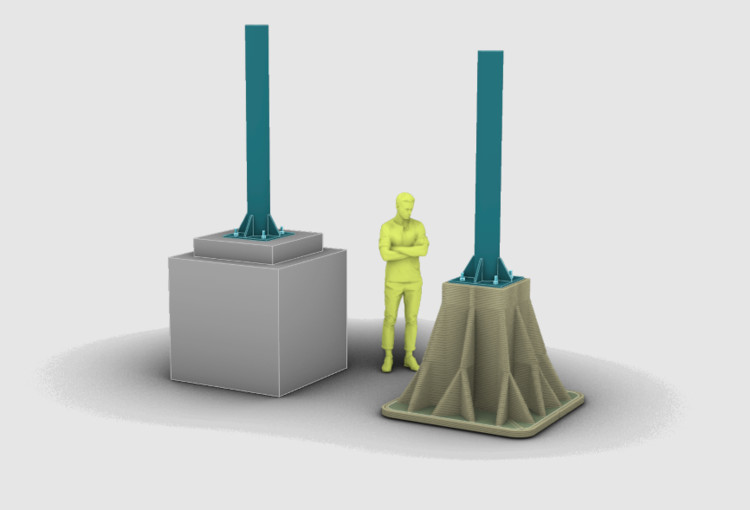
After water, concrete is the second most-consumed material on the planet and its production is substantially growing, expected to increase from 4.4 billion tons, reaching production up to 5.5 billion tons by 2050. Unfortunately, this comes at a huge environmental cost, accounting for almost eight percent of the global carbon emissions. With this estimated expected growth, stakeholders in the construction industry must work on integrating sustainable building materials and innovative processes.
As a renewable energy company with more than 1.2 million kilometers of electric transmission and distribution power lines, Iberdrola needs more transmission networks to facilitate the energy transition from fossil fuels to renewables and transport this green energy to the load centers and to the customers. With the aim to minimize the environmental impact of these new facilities and decrease project costs and lead-times, the energy giant has decided to collaborate with Hyperion Robotics and Peikko Group to apply 3D printing technology to improve the construction of its transmission network.


The solution provided by Hyperion Robotics aims to optimize the construction of electricity transport facilities by boosting efficiency and process productivity. Taking into consideration that construction is the least automated industry, which is currently experiencing shortage of skilled labour force, the solution comes very practical and at the right time. The large-scale 3D printing of low-carbon concrete ensures cheaper, faster, safer, and more environmental-friendly concrete construction.


With its innovative 3D printing Micro-factories, Hyperion Robotics is reducing the amount of structural concrete required by up to 75% and the amount of waste produced significantly. Not only does the solution make the process more sustainable, it also improves health and safety conditions as robots are the ones doing the hard labour whilst workers supervise the process.
Recycling is another problem of the industry that is being solved by Hyperion’s robotic 3D printing solution. Currently, most of the waste material is not being recycled, but the printing system makes it possible to use reinforced low-carbon concrete made with a combination of end-of-cycle materials from the industry such as blast furnace slag, fly ash, mining tailings, and demolition waste, which contribute to significant cost savings and 90% reduction of embodied CO2 emissions.


Hyperion’s latest project in collaboration with the renewable energy company Iberdrola and the supplier of connection technology for concrete elements Peikko Group was just kicked off with the first in the world 3D printed pad foundation.
“This [3d printed] foundation is very special. It has been designed, engineered, and printed with the help of Peikko and Iberdrola. Being the first in the world – it is saving 75% of the material – compared to traditional pad foundation, which you can typically find in energy infrastructures or any other type of projects.” Henry Unterreiner, co-founder at Hyperion Robotics, said.

The innovative 3D printed construction was tested with horizontal and vertical pull and showed that in practice, only 25% of the material is enough to reach the equivalent strength of traditional pad foundations. This is a huge success in terms of CO2 footprint and construction methodology improvements for the long-term future of the industry.
Concrete 3D printing technology and robotics bring significant and exciting new possibilities to the construction industry, improving the carbon footprint and simplifying the production of concrete elements directly from site.
This project is a huge success in terms of eCO2 footprint and construction methodology improvements for the long-term future of the industry. Hyperion is now working to scale up this application of 3D printing and apply it to energy infrastructures with the aim to minimize the environmental impact of these new facilities and decrease project costs and lead-times.
Learn more about this innovation here.
This article is part of the ArchDaily Topics: The Road to Net Zero Architecture presented by Randers Tegl.
Randers Tegl aims to take responsibility and think sustainable as a part of reaching the goal of Net Zero. Both in terms of how building materials impact the climate and how the materials age, but also with a focus on architecture. That is why Randers Tegl created their sustainable series GREENER, which comes with full documentation in the form of EPD, so it is possible to use the product in technical calculation programs.
Every month we explore a topic in-depth through articles, interviews, news, and projects. Learn more about our ArchDaily topics. As always, at ArchDaily we welcome the contributions of our readers; if you want to submit an article or project, contact us.






